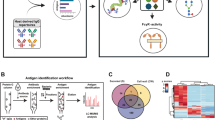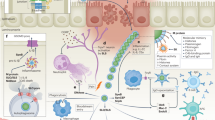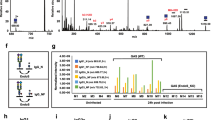Abstract
Most invasive bacterial infections are caused by species that more commonly colonize the human host with minimal symptoms. Although phenotypic or genetic correlates underlying a bacterium's shift to enhanced virulence have been studied, the in vivo selection pressures governing such shifts are poorly understood. The globally disseminated M1T1 clone of group A Streptococcus (GAS) is linked with the rare but life-threatening syndromes of necrotizing fasciitis and toxic shock syndrome1. Mutations in the GAS control of virulence regulatory sensor kinase (covRS) operon are associated with severe invasive disease, abolishing expression of a broad-spectrum cysteine protease (SpeB)2,3 and allowing the recruitment and activation of host plasminogen on the bacterial surface4. Here we describe how bacteriophage-encoded GAS DNase (Sda1), which facilitates the pathogen's escape from neutrophil extracellular traps5,6, serves as a selective force for covRS mutation. The results provide a paradigm whereby natural selection exerted by the innate immune system generates hypervirulent bacterial variants with increased risk of systemic dissemination.
This is a preview of subscription content, access via your institution
Access options
Subscribe to this journal
Receive 12 print issues and online access
$259.00 per year
only $21.58 per issue
Buy this article
- Purchase on SpringerLink
- Instant access to full article PDF
Prices may be subject to local taxes which are calculated during checkout



Similar content being viewed by others
References
Cunningham, M.W. Pathogenesis of group A streptococcal infections. Clin. Microbiol. Rev. 13, 470–511 (2000).
Kansal, R.G., McGeer, A., Low, D.E., Norrby-Teglund, A. & Kotb, M. Inverse relation between disease severity and expression of the streptococcal cysteine protease, SpeB, among clonal M1T1 isolates recovered from invasive group A streptococcal infection cases. Infect. Immun. 68, 6362–6369 (2000).
Sumby, P., Whitney, A.R., Graviss, E.A., DeLeo, F.R. & Musser, J.M. Genome-wide analysis of group A streptococci reveals a mutation that modulates global phenotype and disease specificity. PLoS Pathog. 2, 41–49 (2006).
Cole, J.N. et al. Trigger for group A streptococcal M1T1 invasive disease. FASEB J. 20, 1745–1747 (2006).
Buchanan, J.T. et al. DNase expression allows the pathogen group A Streptococcus to escape killing in neutrophil extracellular traps. Curr. Biol. 16, 396–400 (2006).
Sumby, P. et al. Extracellular deoxyribonuclease made by group A Streptococcus assists pathogenesis by enhancing evasion of the innate immune response. Proc. Natl. Acad. Sci. USA 102, 1679–1684 (2005).
Carapetis, J.R., Steer, A.C., Mulholland, E.K. & Weber, M. The global burden of group A streptococcal diseases. Lancet Infect. Dis. 5, 685–694 (2005).
Walker, M.J., McArthur, J.D., McKay, F.C. & Ranson, M. Is plasminogen deployed as a Streptococcus pyogenes virulence factor? Trends Microbiol 13, 308–313 (2005).
Aziz, R.K. et al. Mosaic prophages with horizontally acquired genes account for the emergence and diversification of the globally disseminated M1T1 clone of Streptococcus pyogenes. J. Bacteriol. 187, 3311–3318 (2005).
Sumby, P. et al. Evolutionary origin and emergence of a highly successful clone of serotype M1 group A Streptococcus involved multiple horizontal gene transfer events. J. Infect. Dis. 192, 771–782 (2005).
Aziz, R.K. et al. Invasive M1T1 group A Streptococcus undergoes a phase-shift in vivo to prevent proteolytic degradation of multiple virulence factors by SpeB. Mol. Microbiol. 51, 123–134 (2004).
Pancholi, V. & Fischetti, V.A. α-Enolase, a novel strong plasmin(ogen) binding protein on the surface of pathogenic streptococci. J. Biol. Chem. 273, 14503–14515 (1998).
Pancholi, V. & Fischetti, V.A. A major surface protein on group A streptococci is a glyceraldehyde-3-phosphate-dehydrogenase with multiple binding activity. J. Exp. Med. 176, 415–426 (1992).
Ringdahl, U. et al. A role for the fibrinogen-binding regions of streptococcal M proteins in phagocytosis resistance. Mol. Microbiol. 37, 1318–1326 (2000).
McArthur, J.D. & Walker, M.J. Domains of group A streptococcal M protein that confer resistance to phagocytosis, opsonization and protection: implications for vaccine development. Mol. Microbiol. 59, 1–4 (2006).
Sun, H. et al. Plasminogen is a critical host pathogenicity factor for group A streptococcal infection. Science 305, 1283–1286 (2004).
Brinkmann, V. et al. Neutrophil extracellular traps kill bacteria. Science 303, 1532–1535 (2004).
Ochman, H. & Moran, N.A. Genes lost and genes found: evolution of bacterial pathogenesis and symbiosis. Science 292, 1096–1099 (2001).
Ferretti, J.J. et al. Complete genome sequence of an M1 strain of Streptococcus pyogenes. Proc. Natl. Acad. Sci. USA 98, 4658–4663 (2001).
Nizet, V. et al. Genetic locus for streptolysin S production by group A Streptococcus. Infect. Immun. 68, 4245–4254 (2000).
Maguin, E., Duwat, P., Hege, T., Ehrlich, D. & Gruss, A. New thermosensitive plasmid for Gram-positive bacteria. J. Bacteriol. 174, 5633–5638 (1992).
Ashbaugh, C.D., Warren, H.B., Carey, V.J. & Wessels, M.R. Molecular analysis of the role of the group A streptococcal cysteine protease, hyaluronic acid capsule, and M protein in a murine model of human invasive soft-tissue infection. J. Clin. Invest. 102, 550–560 (1998).
Collin, M. & Olsen, A. Generation of a mature streptococcal cysteine proteinase is dependent on cell wall-anchored M1 protein. Mol. Microbiol. 36, 1306–1318 (2000).
McKay, F.C. et al. Plasminogen binding by group A streptococcal isolates from a region of hyperendemicity for streptococcal skin infection and a high incidence of invasive infection. Infect. Immun. 72, 364–370 (2004).
Kazmi, S.U. et al. Reciprocal, temporal expression of SpeA and SpeB by invasive M1T1 group A streptococcal isolates in vivo. Infect. Immun. 69, 4988–4995 (2001).
Aziz, R.K., Ismail, S.A., Park, H.W. & Kotb, M. Post-proteomic identification of a novel phage-encoded streptodornase, Sda1, in invasive M1T1 Streptococcus pyogenes. Mol. Microbiol. 54, 184–197 (2004).
Acknowledgements
The authors wish to thank A. Jeng and K. Chalasani for constructing the isogenic mutant 5448Δsmez, and R. Attia for assisting with real-time PCR. A. Hollands and A. Henningham are recipients of Australian Postgraduate Awards. This work was supported by the National Health and Medical Research Council of Australia 459103 (M.J.W.), US National Institutes of Health grant AI48176 (V.N.) and a Department of Employment Science and Technology (Australia) International Science Linkages grant CG001195 (M.J.W., V.N., M.K.). The authors thank G. Ellmers and R. Dinnervill for illustrating Figure 3, and M. Wilson for critically reading this manuscript.
Author information
Authors and Affiliations
Contributions
M.L.S.-S. and M.J.W. constructed strain 5448RCsda1+. A. Hollands and V.N. constructed strains 5448Δska and 5448Δemm1. M.J.W., J.N.C., J.K.K., A. Hollands and R.K.A. undertook covRS DNA sequence analysis. K.D. and G.S.C. undertook plasminogen binding assays. M.J.W., A. Hollands, J.N.C., and J.K.K. performed SpeB, surface plasmin and western blot analyses. A. Hollands, M.L.S.-S., J.N.C., J.K.K., A. Henningham, J.D.M. and M.J.W. performed survival curves and SpeB phenotype switching studies. M.J.W. and R.G.K. implanted mouse infection chambers and R.K.A., R.G.K. and M.K. undertook real-time PCR analysis. A.J.S., J.T.B., A. Hollands, M.J.W. and V.N. performed DNA NET and neutrophil killing assays. M.J.W., G.S.C., M.K. and V.N. supervised the project. M.J.W. coordinated the project. M.J.W., A. Hollands, M.L.S.-S., J.N.C., R.K.A., R.G.K., J.T.B., G.S.C., M.K. and V.N. contributed to writing the manuscript.
Corresponding author
Ethics declarations
Competing interests
The authors declare no competing financial interests.
Supplementary information
Supplementary Text and Figures
Supplementary Figures 1–4, Supplementary Tables 1–3, Supplementary Methods (PDF 504 kb)
Rights and permissions
About this article
Cite this article
Walker, M., Hollands, A., Sanderson-Smith, M. et al. DNase Sda1 provides selection pressure for a switch to invasive group A streptococcal infection. Nat Med 13, 981–985 (2007). https://doi.org/10.1038/nm1612
Received:
Accepted:
Published:
Issue date:
DOI: https://doi.org/10.1038/nm1612
This article is cited by
-
Neutrophil-derived reactive agents induce a transient SpeB negative phenotype in Streptococcus pyogenes
Journal of Biomedical Science (2023)
-
Schistosome egg-derived extracellular vesicles deliver Sja-miR-71a inhibits host macrophage and neutrophil extracellular traps via targeting Sema4D
Cell Communication and Signaling (2023)
-
Moonlighting chromatin: when DNA escapes nuclear control
Cell Death & Differentiation (2023)
-
Pathogenesis, epidemiology and control of Group A Streptococcus infection
Nature Reviews Microbiology (2023)
-
Secreted protease PRSS35 suppresses hepatocellular carcinoma by disabling CXCL2-mediated neutrophil extracellular traps
Nature Communications (2023)



